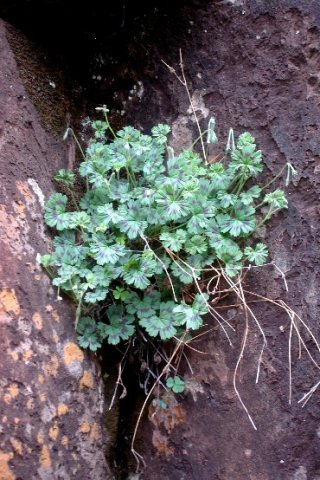Pelargonium ranunculophyllum

Author: Ivan Lätti
Photographer: Judd Kirkel Welwitch
Pelargonium ranunculophyllum, sometimes commonly called the cave storksbill, is a perennial, evergreen shrublet mostly covered in short hairs, growing many soft, fleshy stems that branch into a rounded shape.
The slightly more than semi-circular leaves, almost kidney-shaped, have angular teeth on their margins, spaced into groups by a few deep incisions that form distinct lobes. Halfway to the leaf centre, about at the depth of the lobing, an irregular, maroon to purple horseshoe pattern or zonal marking appears on the pale to blue green leaf surface.
The leaf surfaces have a few notable folds, coinciding with veins that radiate palmately from the leaf centre. That is where the long petiole attaches to the blade. The leaves are about 3 cm in diameter. They resemble the leaves of P. alchemilloides and, according to the plant’s specific name, some plants in the Ranunculus genus.
The species distribution is in the east of South Africa, in the Eastern Cape and KwaZulu-Natal. This plant was seen perching in a rock crevice in the Drakensberg.
The habitat is rocky, montane slopes at elevations over 1000 m. The plants grow in sandstone derived soils. The habitat population is deemed of least concern early in the twenty first century (Gibby, 1989: Pelargonium ranunculophyllum (Geraniaceae) in southern Africa. South African Journal of Botany, 55(6), pp 539-542; iNaturalist; iSpot; https://www.pelargoniumspeciesworld.com; http://redlist.sanbi.org).

